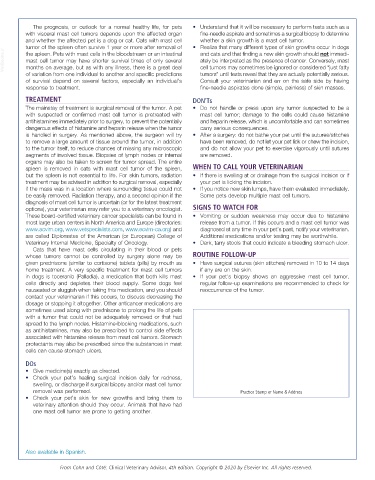Page 3073 - Cote clinical veterinary advisor dogs and cats 4th
P. 3073
The prognosis, or outlook for a normal healthy life, for pets • Understand that it will be necessary to perform tests such as a
with visceral mast cell tumors depends upon the affected organ fine-needle aspirate and sometimes a surgical biopsy to determine
and whether the affected pet is a dog or cat. Cats with mast cell whether a skin growth is a mast cell tumor.
tumor of the spleen often survive 1 year or more after removal of • Realize that many different types of skin growths occur in dogs
VetBooks.ir mast cell tumor may have shorter survival times of only several ately be interpreted as the presence of cancer. Conversely, mast
and cats and that finding a new skin growth should not immedi-
the spleen. Pets with mast cells in the bloodstream or an intestinal
cell tumors may sometimes be ignored or considered “just fatty
months on average, but as with any illness, there is a great deal
of variation from one individual to another and specific predictions tumors” until tests reveal that they are actually potentially serious.
of survival depend on several factors, especially an individual’s Consult your veterinarian and err on the safe side by having
response to treatment. fine-needle aspirates done (simple, painless) of skin masses.
TREATMENT DON’Ts
The mainstay of treatment is surgical removal of the tumor. A pet • Do not handle or press upon any tumor suspected to be a
with suspected or confirmed mast cell tumor is pretreated with mast cell tumor; damage to the cells could cause histamine
antihistamines immediately prior to surgery, to prevent the potentially and heparin release, which is uncomfortable and can sometimes
dangerous effects of histamine and heparin release when the tumor carry serious consequences.
is handled in surgery. As mentioned above, the surgeon will try • After a surgery: do not bathe your pet until the sutures/stitches
to remove a large amount of tissue around the tumor, in addition have been removed, do not let your pet lick or chew the incision,
to the tumor itself, to reduce chances of missing any microscopic and do not allow your pet to exercise vigorously until sutures
segments of involved tissue. Biopsies of lymph nodes or internal are removed.
organs may also be taken to screen for tumor spread. The entire
spleen is removed in cats with mast cell tumor of the spleen, WHEN TO CALL YOUR VETERINARIAN
but the spleen is not essential to life. For skin tumors, radiation • If there is swelling at or drainage from the surgical incision or if
treatment may be advised in addition to surgical removal, especially your pet is licking the incision.
if the mass was in a location where surrounding tissue could not • If you notice new skin lumps, have them evaluated immediately.
be easily removed. Radiation therapy, and a second opinion if the Some pets develop multiple mast cell tumors.
diagnosis of mast cell tumor is uncertain (or for the latest treatment
options), your veterinarian may refer you to a veterinary oncologist. SIGNS TO WATCH FOR
These board-certified veterinary cancer specialists can be found in • Vomiting or sudden weakness may occur due to histamine
most large urban centers in North America and Europe (directories: release from a tumor. If this occurs and a mast cell tumor was
www.acvim.org, www.vetspecialists.com, www.ecvim-ca.org) and diagnosed at any time in your pet’s past, notify your veterinarian.
are called Diplomates of the American (or European) College of Additional medications and/or testing may be worthwhile.
Veterinary Internal Medicine, Specialty of Oncology. • Dark, tarry stools that could indicate a bleeding stomach ulcer.
Cats that have mast cells circulating in their blood or pets
whose tumors cannot be controlled by surgery alone may be ROUTINE FOLLOW-UP
given prednisone (similar to cortisone) tablets (pills) by mouth as • Have surgical sutures (skin stitches) removed in 10 to 14 days
home treatment. A very specific treatment for mast cell tumors if any are on the skin.
in dogs is toceranib (Palladia), a medication that both kills mast • If your pet’s biopsy shows an aggressive mast cell tumor,
cells directly and depletes their blood supply. Some dogs feel regular follow-up examinations are recommended to check for
nauseated or sluggish when taking this medication, and you should reoccurrence of the tumor.
contact your veterinarian if this occurs, to discuss decreasing the
dosage or stopping it altogether. Other anticancer medications are
sometimes used along with prednisone to prolong the life of pets
with a tumor that could not be adequately removed or that had
spread to the lymph nodes. Histamine-blocking medications, such
as antihistamines, may also be prescribed to control side effects
associated with histamine release from mast cell tumors. Stomach
protectants may also be prescribed since the substances in mast
cells can cause stomach ulcers.
DOs
• Give medicine(s) exactly as directed.
• Check your pet’s healing surgical incision daily for redness,
swelling, or discharge if surgical biopsy and/or mast cell tumor
removal was performed. Practice Stamp or Name & Address
• Check your pet’s skin for new growths and bring them to
veterinary attention should they occur. Animals that have had
one mast cell tumor are prone to getting another.
Also available in Spanish.
From Cohn and Côté: Clinical Veterinary Advisor, 4th edition. Copyright © 2020 by Elsevier Inc. All rights reserved.

